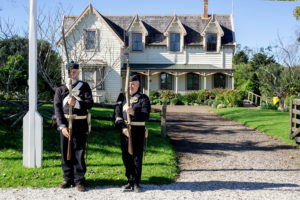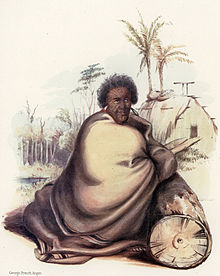1863: Oath of Betrayal
July 28, 2019
By AHNZ
 If any one man is responsible for the Waikato War then it is this man, Tamati Ngapora. If he was New Zealand’s greatest traitor then it is only because he was so respected and relied upon to be entrusted with supreme responsibility. After Ngapora’s betrayal The State unleashed the dogs of war and invaded the Waikato on 17 July 1863.
If any one man is responsible for the Waikato War then it is this man, Tamati Ngapora. If he was New Zealand’s greatest traitor then it is only because he was so respected and relied upon to be entrusted with supreme responsibility. After Ngapora’s betrayal The State unleashed the dogs of war and invaded the Waikato on 17 July 1863.
Auckland’s Protectors
New Zealand’s capital city had been founded in a kill box. Once a rich urban paradise, the Auckland isthmus was transformed by musket technology into a depopulated waste land because it would take the martial force of a global super power to hold it now. For a long time there were no takers although the French, British, Americans, and Russians all had a good sniff around.
 Eventually someone did come along: The Hobson Gang. Excusing themselves from the major British exercise of the Opium War, the Hobson Gang shot down to the South Seas independent islands of New Zealand to take them over! With a flourish of gifts, guns, military regalia, and creative interpretations of the Admiralty’s instructions they had early success. By 1841 they were strong enough and ready to hold the Kill Box Isthmus and name it after William Hobson’s mentor, Lord Auckland.
Eventually someone did come along: The Hobson Gang. Excusing themselves from the major British exercise of the Opium War, the Hobson Gang shot down to the South Seas independent islands of New Zealand to take them over! With a flourish of gifts, guns, military regalia, and creative interpretations of the Admiralty’s instructions they had early success. By 1841 they were strong enough and ready to hold the Kill Box Isthmus and name it after William Hobson’s mentor, Lord Auckland.
Auckland continued to be existentially threatened from all sides. The citizens lived in terror from time to time. For example, we withstood an invasion in 1851 which Governor George Grey repelled like a master. Auckland’s early protectors founded seven defensive communities at her northern and southern frontiers; Both Maori and Settler. The Southern Sentinels were Panmure, Howick, Otahuhu, Onehunga, and Mangere.
Mangere Fencibles
 Tamati Ngapora left his home in the Waikato, moving his Tainui sub-tribe to Mangere in 1849¹. Just as with the English/Irish Settlers, Tamati’s people accepted the charge of guarding Auckland’s back door from hostile invaders. For some 10 years Tamati and his people prospered and built their new community in the alliance of the new New Zealand.
Tamati Ngapora left his home in the Waikato, moving his Tainui sub-tribe to Mangere in 1849¹. Just as with the English/Irish Settlers, Tamati’s people accepted the charge of guarding Auckland’s back door from hostile invaders. For some 10 years Tamati and his people prospered and built their new community in the alliance of the new New Zealand.
 Along with being the chief, Ngapora had official capacity as Assessor alongside the Resident Magistrate and was the first lay preacher/leader in the Anglican stone church he and his people built which still stands today. Ngapora had superior² education and talents over many or most chiefs, including the future Maori king Te Wherowhero who moved to Mangere during this time too.
Along with being the chief, Ngapora had official capacity as Assessor alongside the Resident Magistrate and was the first lay preacher/leader in the Anglican stone church he and his people built which still stands today. Ngapora had superior² education and talents over many or most chiefs, including the future Maori king Te Wherowhero who moved to Mangere during this time too.
“it was agreed that a group of Maori under Chieftain Tamati Ngapora would move to Mangere and act in much the same role as the Fencibles who were in Onehunga”
“Tamati’s picture along with that of Bishop Selwyn hang on the rear wall of the vestry.”
“They were to be subject to the same rules as the Fencibles in that they would parade once per year, supply their own muskets and live off the land to which they had been allotted.” – History of St James Anglican Church; st-james-nz.org
Thus the people of Auckland slept safely under the protection Ngapora provided. Then, he turned away.
King Te Wherowhero
 In 1858 Potatau Te Wherowhero became the first Maori King. We previously met this man as the genocidal butcher of the Taranaki in 1832. “Future royalty, Te Wherowhero, killed hundreds of prisoners until his arm became so tired bludgeoning with his bloody greenstone club he had to stop. But still he wanted more Taranaki slaughter.” This image (left) drawn by George Angas Jr (in his The Simpsons style.)
In 1858 Potatau Te Wherowhero became the first Maori King. We previously met this man as the genocidal butcher of the Taranaki in 1832. “Future royalty, Te Wherowhero, killed hundreds of prisoners until his arm became so tired bludgeoning with his bloody greenstone club he had to stop. But still he wanted more Taranaki slaughter.” This image (left) drawn by George Angas Jr (in his The Simpsons style.)
Auckland’s protector, Mangere’s chief and clergyman, Tamati Ngapora, was initially opposed to the invention of a Maori King. New Zealand already had a Crown to whom all Maori were subjects, why flirt with treason? Yet when Te Wherowhero departed Mangere, and became the first King, Ngapora defected to his Crown.
With this betrayal, Auckland had lost her first line of defence. Ngapora remained in Mangere but the function he and his people performed with honour for 10 years was no longer tenable. Initially, Ngapora tried to play it both ways and re-invent himself as the representative delegate of the new Royal Family. When the proverbial hit the fan, he left Mangere to take the position as Te Wherowhero’s Prime Minister³.
Invasion of the Waikato
For five years Ngapora struggled to bridge the two Crowns he had placed himself and his people between. In the years since Te Wherowhero became Regal the Waikato Maori had been escalating a war-footing. Ngapora warned Governor Grey that war parties were gathering to attack outposts toward making a surprise attack on Auckland.⁴
Governor Grey resolved to get in first and unleash the dogs of war on his upstart competition. Ngapora’s defection paved the way. Auckland had lost her moral and military front line of the past decade to the enemy. If he would not hold his station, would not stand up for his King and Country any longer, then what now held war at bay?
Grey gave Ngapora and his people one more chance to pick a side and keep the land given to them by the British Crown: The Oath of Allegiance….
“You are now assembling in armed bands; you are constantly threatening to come down the river to ravage the Settlement of Auckland and to murder peaceable settlers. Some of you offered a safe passage through your territories to armed parties contemplating such outrages”
“Those who remain peaceably at their own villages in Waikato..will be protected in their persons, property, and land. Those who wage war against Her Majesty, or remain in arms, threatening the lives of Her peaceable subjects, must take the consequences of their acts,”- Oath of Allegiance, 9 July 1863
This Oath was especially for Ngapora and the people reliant upon him. Once were Auckland’s friends and protector sentinels. Where did they stand now? Choose your side.
Ngapora refused to take the oath and instead exited the Mangere frontier, choosing the Maori Crown over the British. The Exodus down Great South Road begun, those leaving Auckland finally showing which side they were really on. There are no reports of damage and the train south involved some 50 horses. The turncoats did not have much time to make their decision and evacuate themselves and their property, little over a day. However, this is a more dignified exit than enemies of a State usually get. And, this day had been coming for a long time now.
 Ngapora lived on until 1885, long enough to be forgiven. His confiscated church and cemetery were returned in 1867. Mainstream history downplays his betrayal, especially these days, focusing instead on warmongering Governors who couldn’t help themselves; Mean white people; Nasty Colonialism…
Ngapora lived on until 1885, long enough to be forgiven. His confiscated church and cemetery were returned in 1867. Mainstream history downplays his betrayal, especially these days, focusing instead on warmongering Governors who couldn’t help themselves; Mean white people; Nasty Colonialism…
I wonder if he thought he was creating Mangere as some kind of Switzerland? Did he want to create a neutral ground between Crown and Crown? Had he pulled such a thing off he would be remembered in the tradition of a great peacemaker, perhaps producing a new Treaty of Mangere as a founding constitutional document? No proof. What did happen was that Ngapora deserted his post. And when the time to pick a side was forced upon him, he choose the doomed.
—
Note (12/2020:) Ihumatao was part of the land given to Ngapora and his people in exchange for their being allies. When they defected, the deal was broken and the land taken back. Some of the land was returned as a peace gesture after the war and this included the church but not Ihumatao.
1 Ngapora biography; teara.govt.nz
2 ODT (1871)
3 ibid
4 Ngapora biography, ibid
Image ref. Tamati Ngapora Manuhiri; Auckland Art Gallery
Image ref. Howick Historical Villiage’s soldiers; fencible.org.nz
Image ref. St James Church, Mangere; AHNZ files (Feb 2018)
 Like Comment Share
Like Comment Share






2 thoughts on "1863: Oath of Betrayal"